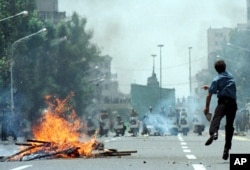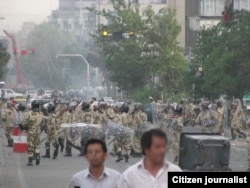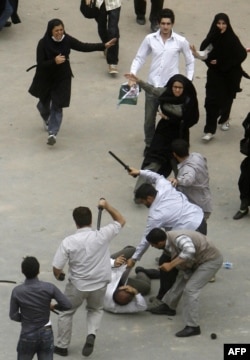It remains to be seen if this latest round of protests in Iran will continue to gain momentum or not. One thing is for certain, the Islamic Republic is skilled at “managing” a discontented populous—opposition activists call it suppression. What are the coercive tools and mechanisms used in Iran to silence dissent?
There have been five major waves of unrest in Iran since the Islamic Revolution in 1979, three within the last decade. All were quashed by the regime. Of those within the last ten years, the first was the post-election protests of 2009, then the nationwide protests beginning in December last year, and recently the post-sanctions wave.
Looking at the evidence from all five major episodes of protests, it is clear that regime forces that suppress dissent are multi-layered and multi-dimensional. After each round of unrest, the organization, methods, and the means used have become more sophisticated.
The system that counters protests in Iran is not made up of just the police and official law enforcement. It encompasses paramilitary forces, intelligence organs, operations units, judicial organs, media, the propaganda machinery, and even financial structures.
First layer: Intelligence
As in other authoritarian countries, the Islamic Republic’s first line of defense against opponents is intelligence.
Studying thousands of legal cases brought against Iran’s dissidents in the last three decades shows various intelligence agencies untiringly collecting information on critics and opponents of the regime. In some cases, even before a protest takes place authorities arrest the organizers.
The Islamic Republic officially acknowledges the existence of 16 different intelligence organizations, each with a different role in suppressing dissent.
There are four that have been particularly active in the last decade. The Intelligence Ministry, The Islamic Republic Police Intelligence Unit, the Justice Department’s counter-intelligence, and the Islamic Revolutionary Guards Corps (IRGC) Intelligence Organization.
The actual role of these primary actors at any given time depends on the internal alignment of regime forces and how relations are between the executive branch, headed by the president, and the office of the Supreme Leader and his ally, the IRGC.
The Intelligence Ministry, from its inception in 1983 to the present, has played the most central role in the arrest and persecution of dissidents, except at times when the president’s relations with the Supreme Leader have not been very close. In those periods, the role of other intelligence organs, such as that of the IRGC, have become more prominent. One such period was during the presidency of reformist Mohammad Khatami (1997-2005).
The IRGC’s intelligence unit has become more prominent in the last decade, as its status was upgraded from a directorate to the level of an organization. As a result, the suppression of regime opponents has intensified. In many cases it is obvious that the IRGC Intelligence Organization wields more power than the Intelligence Ministry.
Second Layer: Operations
The following four groups serve a key operational role in suppressing protest movements: regular police, police special forces, Basij forces under IRGC command, and the IRGC itself, especially the Imam Ali security units.
Depending on the regime’s threat estimate from any given protest, the composition of operational forces always changes. In some instances, regular police are deployed, while in others Basij or heavily armed IRGC units come into play.
Third Layer: The Judiciary
Judicial organs, composed of interrogators, prosecutors, judges, and prison authorities are responsible for building legal cases against opponents and issuing verdicts ranging from fines to imprisonment to exile.
Opponents of the regime say that many judicial officials are in fact under the control of intelligence organs. Interrogators are all intelligence officers, and judges often have to follow their wishes in dealing with dissidents.
Fourth Layer: Media
A multitude of media outlets controlled by the IRGC, Basij, Judiciary and state broadcasting controlled by the Supreme Leader all coalesce to assist in suppressing dissent.
Opponents of the regime maintain that these outlets work in close cooperation with intelligence and other organizations to create the right atmosphere for action against protesters. For example, the state broadcaster regularly airs “confessions” by activists in an attempt to turn public sentiment against them.
Critics of the Iranian regime also say that the media has greatly expanded its propaganda activities recently, producing films and documentaries with considerable budgets.
Fifth Layer: Plainclothes loyal forces
In all the five major protest waves, plainclothes individuals loyal to the regime have played a major role in controlling unrest.
These people, formed into organized groups, are usually seen in the first line of confrontation with protesters and they are usually more active and motivated than uniformed personnel.
In almost three decades since the appearance of these regime supporters in street confrontations, their tactics, command and control systems, organization, as well as physical attack tactics have evolved and become more sophisticated.
When plainclothes groups first came into existence around 1990, they were used to intimidate regime critics and attack newspaper offices, publishers, and some political personalities. Later they were deployed to suppress street protests.
Sixth Layer: Financial and logistical means
There are two ways the regime finances its suppression of dissent.
The first is outlays from the regular government budget in the form of line-items for special police forces, Basij, intelligence organs, the IRGC, and state media.
Comparing government budgets over the years shows that appropriations for these agencies has steadily increased. Each time they were given an additional duty in controlling opponents and dissent, their budget increased proportionally.
For example, as the IRGC intelligence was elevated from a “unit” to the status of an “organization” and assumed a central role in suppression, a separate budget was allotted for it. The same applies to the expansion of Basij organization and media outlets.
The second, is non-official financing for non-uniformed regime supporter groups. Their budget remains hidden in the budget appropriations for the official organs, such as intelligence organizations and the IRGC. The state also provides a variety of financial support mechanisms for loyal groups, some from religious institutions and mosques.
Conclusion
In the final analysis, all the state organs playing a central role in suppressing dissent are directly or indirectly under the control of the Supreme Leader, ayatollah Ali Khamenei, who is not a popularly elected head of state. This is also true about the Intelligence Ministry, which nominally is accountable to the elected president.













